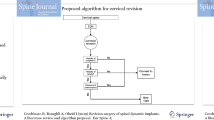Abstract
Cosmic is a pedicle screw rod system for surgically stabilising therapy-resistant lumbagos and lumbar radiculopathies without performing a spinal fusion. After 2 years, the clinical results were found to be comparable to those achieved with spinal fusion. The complication rate including complications in relation to the implant is equivalent to the lower-to-middle third of the complications reported after spinal fusion. While using the cosmic system, attention to the contraindications is essential. No more than three segments may be stabilised and stabilisation must only be performed in situ, where slight distractions up to 4 mm in the segment are permissible. Stabilisation with cosmic, but without spinal fusion offers the following advantages: a reduction in surgical trauma, avoidance of pain via the bone-chip extraction site and preservation of the intervertebral cartilage; this means that the damping function of the intervertebral cartilage is retained. For low invasive implantation, a cosmic screw with a tulip head (cosmic mia) and special instruments are designed. Spontaneous fusions were not observed during the period of observation, but it is assumed that the stabilisation will cause fibrous rigidity over time. No reduction in the height of the intervertebral cartilages in the adjacent segment was found after 2 years. The question as to whether the risk of connection segment instabilities can be reduced with cosmic stabilisation in comparison to fusions can only be answered after a longer follow-up.
Similar content being viewed by others
References
Fujiwara A, Tamai K, Yamato M, et al. (1999) The relationship between facet joint osteoarthritis and disc degeneration of the lumbar spine: an MRI study. Eur Spine J 8: 396–401
Fujiwara A, Lim TH, An HS, et al. (2000) The effect of disc degeneration and facet joint osteoarthritis on the segmental flexibility of the lumbar spine. Spine 25: 3036–3044
Krismer M, Haid C, Behensky H, et al. (2000) Motion in lumbar functional spine units during side bending and axial rotation moments depending on the degree of degeneration. Spine 25: 2020–2027
Tanaka N, An HS, Lim TH, et al. (2001) The relationship between disc degeneration and flexibility of the lumbar spine. Spine J 1: 47–56
Ghiselli G, Wang JC, Bhatia NN, et al. (2004) Adjacent segment degeneration in the lumbar spine. J Bone Joint Surg Am 86-A: 1497–1503
Park P, Garton HJ, Gala VC, et al. (2004) Adjacent segment disease after lumbar or lumbosacral fusion: review of the literature. Spine 29: 1938–1944
Chosa E, Goto K, Totoribe K, Tajima N (2004) Analysis of the effect of lumbar spine fusion on the superior adjacent intervertebral disk in the presence of disk degeneration, using the three-dimensional finite element method. J Spinal Disord Tech 17: 134–139
Brantigan JW, Neidre A, Toohey JS (2004) The Lumbar I/F Cage for posterior lumbar interbody fusion with the variable screw placement system: 10-year results of a Food and Drug Administration clinical trial. Spine J 4: 681–688
Rahm MD, Hall BB (1996) Adjacent-segment degeneration after lumbar fusion with instrumentation: a retrospective study. J Spinal Disord 9: 392–400
Schmölz W, Martin A, Onder U, von Strempel A (2008) Biomechanical evaluation of a pedicle based dynamic stabilisation device. 1. International symposium on nonfusion technologies in degenerated diseases of the lumbar spine, Munich, Germany, 14–16 February
Scifert JL, Sairyo K, Goel VK, et al. (1999) Stability analysis of an enhanced load sharing posterior fixation device and its equivalent conventional device in a calf spine model. Spine 24: 2206–2213
Goel VK, Konz RJ, Chang HT, et al. (2001) Hingeddynamic posterior device permits greater loads on the graft and similar stability as compared with its equivalent rigid device. JPO 13: 17–22
Ettinger C (2002) Testreport No 27.011019.30.95, Endolab Mechanical Engineering Rosenheim, Germany, pp. 1–7
Lacefield WR (1998) Current status of ceramic coating for dental implants. Implant Dentistry 7: 315–318
Sanden B, Olerud C, Petren-Mallmin M, Larsson S (2002) Hydroxyapatite coating improves fixation of pedicle screws. A clinical study. J Bone Joint Surg Br 84: 387–391
Niemeyer T, Bövingloh AS, Halm H, Liljenqvist U (2004) Results after anterior-posterior lumbar spinal fusion: 2–5 years follow-up. Int Orthop 28(5): 298–302
Author information
Authors and Affiliations
Corresponding author
Rights and permissions
About this article
Cite this article
von Strempel, A. Dynamic stabilisation: cosmic system. Interact Surg 3, 229–236 (2008). https://doi.org/10.1007/s11610-007-0044-4
Published:
Issue Date:
DOI: https://doi.org/10.1007/s11610-007-0044-4




